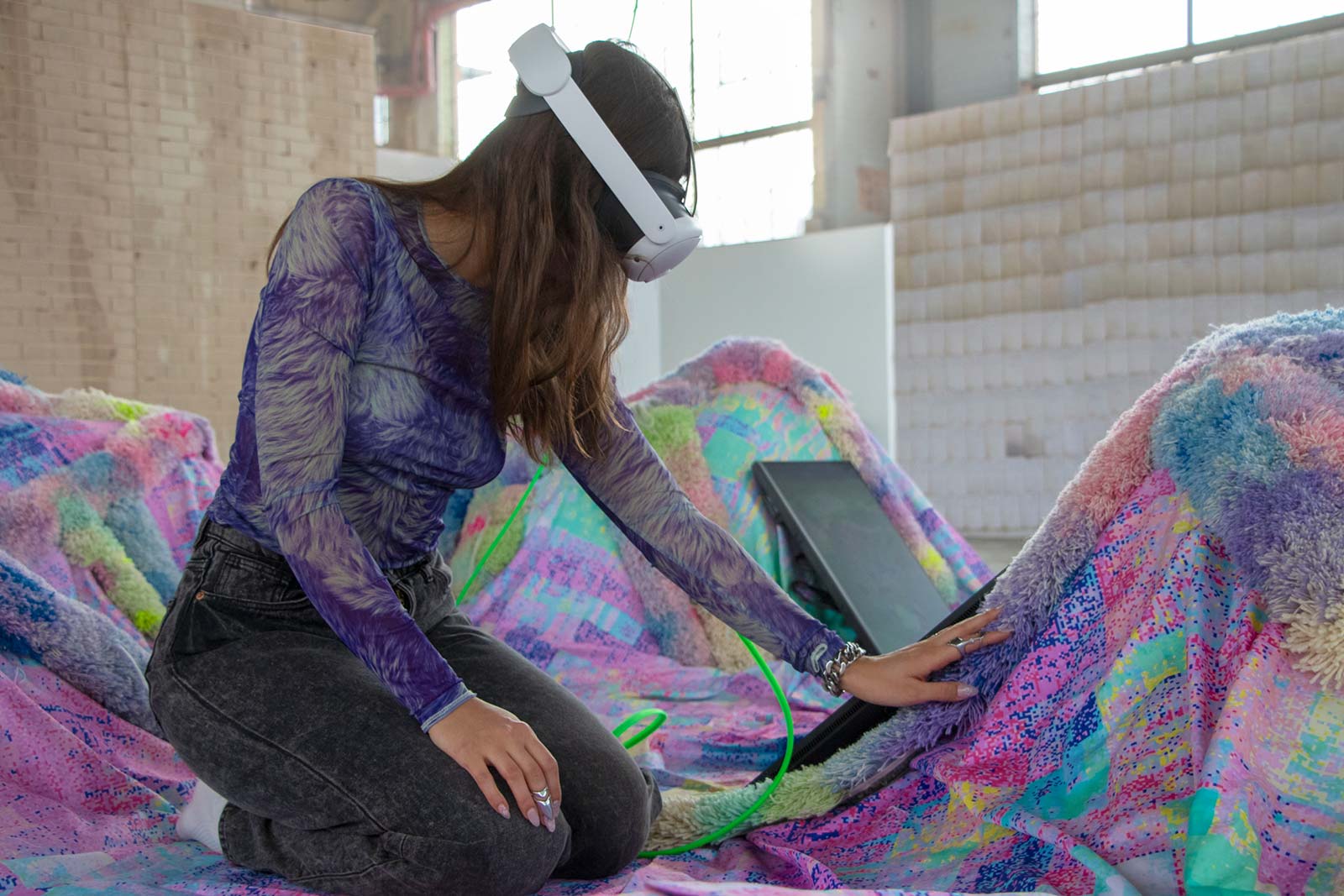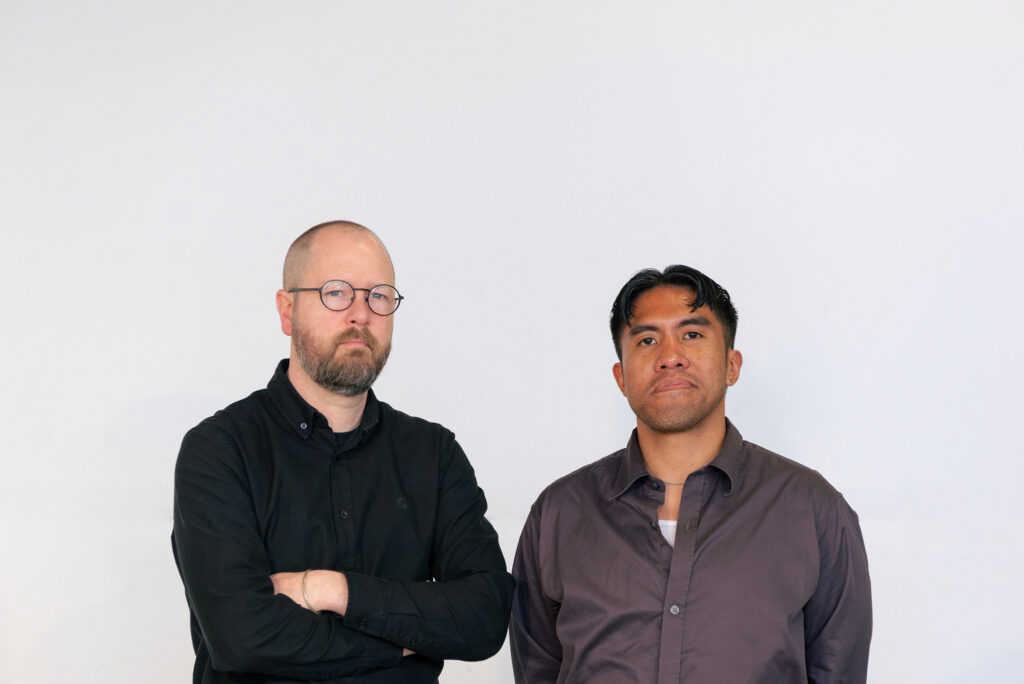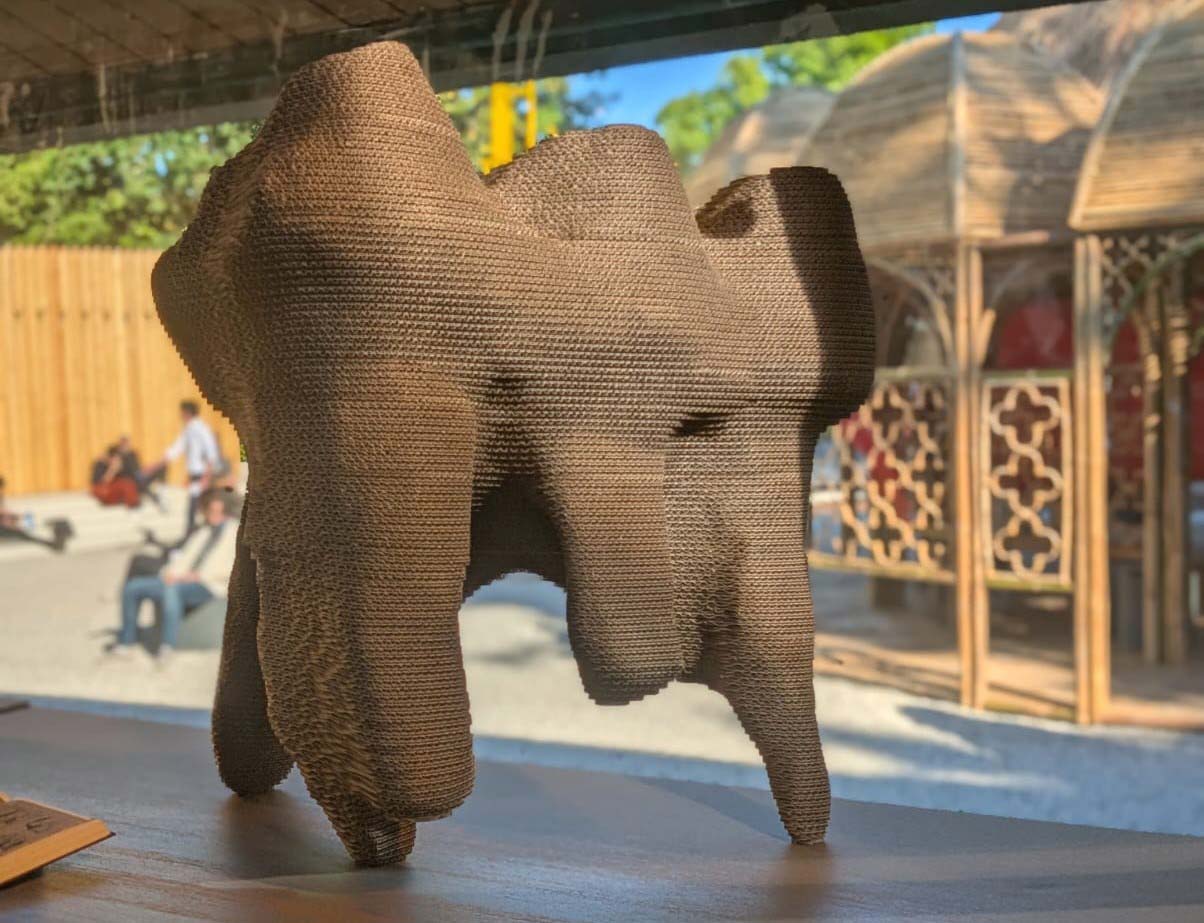
Taubman Fellows Present a Gathering of Worlds in “Touch Points” Exhibition, Public Gallery Hours
From the secreting labor of silkworms to the migratory lives of a public housing development in Rome, from the fantasies of the perfect home to the silvery handholds of commercial building space, the public is invited to witness and interact with a gathering of worlds at the Taubman Fellows Exhibition, “Touch Points,” from November 17, 2023, through March 23, 2024, at the Liberty Research Annex and Gallery in downtown Ann Arbor. The gallery is open to the public and free of charge from 1 to 5 p.m. on scheduled Saturdays.
Taubman Fellows Strat Coffman, Salam Rida, Anna Mascorella, and Alina Nazmeeva encourage exhibition visitors to take off their hats and don others, bear witness, and push against familiar fixtures into stranger lands with a collection of projects related to their research.
More than 100 fellows have completed the Taubman College Fellowship Program since it began in 1984, nearly four decades ago. The fellowship program serves as a conduit for innovation and a bellwether of cultural changes in the architectural industry. The influence of this elite network radiates across the U.S. and worldwide. To date, approximately 20 former fellows have remained at Taubman College, where they are now permanent faculty members.
Erotica Generica
Strat Coffman
“Erotica Generica” sits somewhere between an appliance petting zoo and a softened workplace lounge, where architecture relishes in, rather than repressing, it’s capacity to open pathways of anonymous contact, in sharing heat, swapping glances and bacteria, and trading pressure. Elasticated push plates wobble across a jamb, a flock of knobs slide through the wall, plush panic bars assemble into a clicking bed, and wayward architectural energies are spawned.
Silvery, smooth, and chilled–an ambient armor surrounds us, condensing where and how we touch the built world. Bars, rails, handles, plates. These standard commercial building fixtures solicit our caresses–they are how we gain a handle or find footing. While they are designed to be easily sanitized and scrubbed of touching traces, they unavoidably collect our fingerprints, oils, germs, and heat, tethering us to one another, in anonymity—every door knob we share with a strangely intimate community of strangers. “Erotica Generica” allows these binding agents to multiply, inflate, and slip down the wall, shifting beyond their mandate to secure and expedite. The work unearths the latent erotic exchanges these fixtures, and architectures of the generic, host. What can happen when we wake up to how intimate it is to handle a building?
Team
- Strat Coffman
- Martin Rodriguez (Design & Fabrication)
- Osama Sukkar (Design & Fabrication)
- Jiabao Zhu (Design & Fabrication)
- Sabrina Ramsay (Sewing Design & Fabrication)
- Bryan Wilson (Sewing Design & Fabrication)
- Additional help by Chris Humphrey,
- Philippe Kame, Sydney Sinclair, Sophie Mỹ Hạnh
- Nguyễntrần, and Rich Coffman
Rehousing Rome: From Self-Built Settlements to Fascist-Built Borgate
Anna Mascorella, Fishman Fellow
“Rehousing Rome: From Self-Built Settlements to Fascist-Built Borgate” bears witness to the families displaced and rehoused during the Fascist regime’s redesign of Rome. Through mapping, photographs, architectural drawings, and administrative records, the exhibition charts the lived experience of Rome’s early twentieth-century housing crisis by following the migration of families from self-built housing to the public housing development, Borgata Gordiani, rapidly built by the regime.
The installation centers on the wall-mounted display of reproductions of the 749 administrative records that registered every family relocated to Borgata Gordiani in 1933 and 1934. Counting the number of family members declared on each form, these administrative records represent 4,113 individuals—a magnitude that reflects only a small portion of those displaced and rehoused under the regime.
Team
- Anna Mascorella
- Ipsha Patel
- With additional assistance from Shreya Vadrevu
Welcome Home
Salam Rida
“Welcome Home” serves as a reminder that housing is not merely a collection of buildings but a reflection of societal values and power dynamics. It challenges us to re-examine our assumptions and embrace our role as catalysts for positive social change. By advocating for equitable and inclusive housing policies, we can work towards creating a world where “Welcome Home” truly resonates with its intended meaning – a place of belonging, safety, and opportunity for all.
In the realm of architecture, urban design, and planning, the concept of “home” often evokes images of functional structures and well-designed spaces. However, the true essence of home extends far beyond physical boundaries, encompassing a complex interplay of housing policies, historical narratives, and deeply ingrained social imaginaries. The installation “Welcome Home” invites the audience to explore this intricate tapestry, challenging conventional perspectives and fostering a deeper understanding of the profound impact of housing on individual, collective identities, and its ability to flourish.
Through a blend of visual and textual elements, “Welcome Home” juxtaposes idealized representations of homeownership with stark depictions of substandard housing conditions and segregation. Photographs, architectural models, and evocative narratives intertwine to expose the systemic discrimination embedded within housing policies, revealing the stark realities that often lie hidden beneath the surface of idealized housing campaigns.
Visitors are encouraged to engage with the material that shapes our understanding of housing and its impact on individual and collective identities. Over the next couple of months, events will be held on-site where questions are posed, prompting reflection on the role of architects, urban designers, and planners in shaping the social fabric of communities. Can architecture truly foster a sense of belonging and inclusivity? How can we design housing that transcends mere physical structures and embodies the true essence of “home”?
bug in my software
Alina Nazmeeva
The bug in my software makes it run: the second most numerous domesticated creature, the silkmoth, has been altered by humans to the point of losing their ability to smell, see, and fly. These cute creatures – whose Pokemon-like appearance is a byproduct of this genetic manipulation- are instrumentalized for silk production, and boiled alive inside their cocoons when their metamorphosis is nearly complete so that the silk threads can be harvested intact. Recent experiments that splice spider DNA into silkworms to make the strongest natural fiber on Earth further blur the lines between the organic and the engineered.
Created with plural AI models, the bug in my software pairs physical textile installation and a speculative ecosystem simulation. Here, silkmoths embody the intersection of biological manipulation and technological advancement. In this nexus, the industrialization of natural processes parallels the exploitation of gendered biases, whether in textile production or AI development. Textile labor, historically devalued and predominantly female, finds its echo in the gendered design of AI: voice assistants, caregiving bots, and virtual helpers, often feminized in voice, form, and function, designed to be docile, soothing, accommodating, and perpetually available.
The installation employs the silkmoth’s DNA sequence, transformed into a visual pattern that is both a blueprint and a historical document, extended with soft wool yarn structures that give form to the genetic imprints altered by human hands. Here, the AI agents are weavers of a new world, spinning the detritus of electronic waste into the web of an emergent ecosystem.
Bug in my software invites you to embed yourselves: find a position, feel the ground, envelop in the landscape, contemplate, cuddle, and rest while creatures work, threads weave, and GPU fans spin.
Team
- Alina Nazmeeva
- John Wagner (Concept, Design & Fabrication)
- Ngoc Minh Dang (Fabrication & Textile Production)
- Talia Morison-Allen (Fabrication & Textile Production)
- Daria Guseinova (Fabrication & Textile Production)
- Clarence Song (Fabrication)
- Yi-Chin Lee (Textile Production)
- Iain G (Software Development)
- Shoaib Mujtaba (Software Development)









